Art Fairs
As Frieze London Turns 20, the Art Fair Trades Risk for Reward, Serving Up Palatable Offerings to a Softer Market
In a jittery market, there is more emphasis on works that charm rather than challenge.
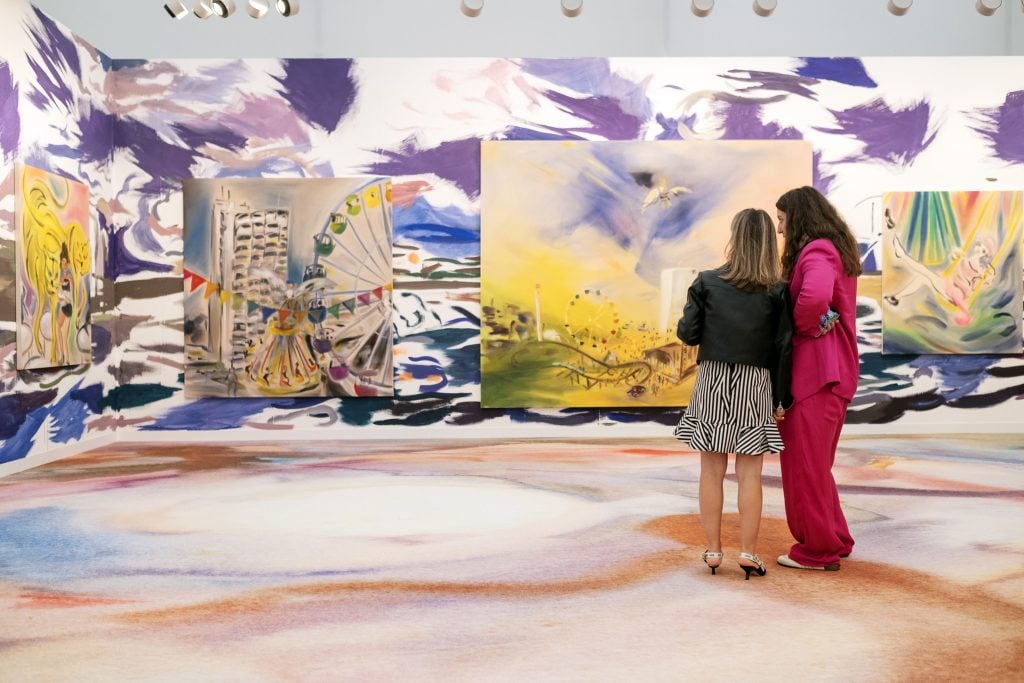
In a jittery market, there is more emphasis on works that charm rather than challenge.

Naomi Rea

There was a sense of intensity and focus among the early-bird visitors to the Frieze art fair (October 11–15, 2023) on its 20th anniversary in London’s Regent’s Park, with smooth entry to the signature white tent that offered a marked contrast to the scrum many visitors complained about last year.
Celebrities including Florence Pugh, Stormzy, and Rami Malek were among the VIPs given early access, but the guest list for the prime slot felt like it was pared back, and skewed more towards serious art world heavyweights who were ready to spend, including American collectors Don and Mera Rubell, Swiss mega-collector Uli Sigg, Italian Patrizia Sandretto Re Rebaudengo, Belgian Alain Servais, and local patrons Paul Ettlinger and Irene Panagopoulos.
All were very complimentary about the fair’s organization this year, and Sigg was particularly impressed with the efficiency of the sandwich queue. Still, things picked up as the day progressed, and by 3 p.m. the tent was heaving with glamorous and eccentrically dressed art lovers. There was no sign of Prime Minister Rishi Sunak, although he collects and has been known to attend. Sunak did, however, host a cohort of U.K. arts leaders at Number 10 last night, signaling a vote of confidence in the country’s art market, though he gave few reassurances that his government—which has slashed public funding for the arts and deemphasized arts in education—would be changing tack in real terms. Dealer Thaddaeus Ropac was among the attendees.
“I was happy because this is a very European tradition—in Paris President Macron hosts us at the Elysée—and it’s a positive sign when public figures of this caliber and importance embrace the art world,” Ropac said.
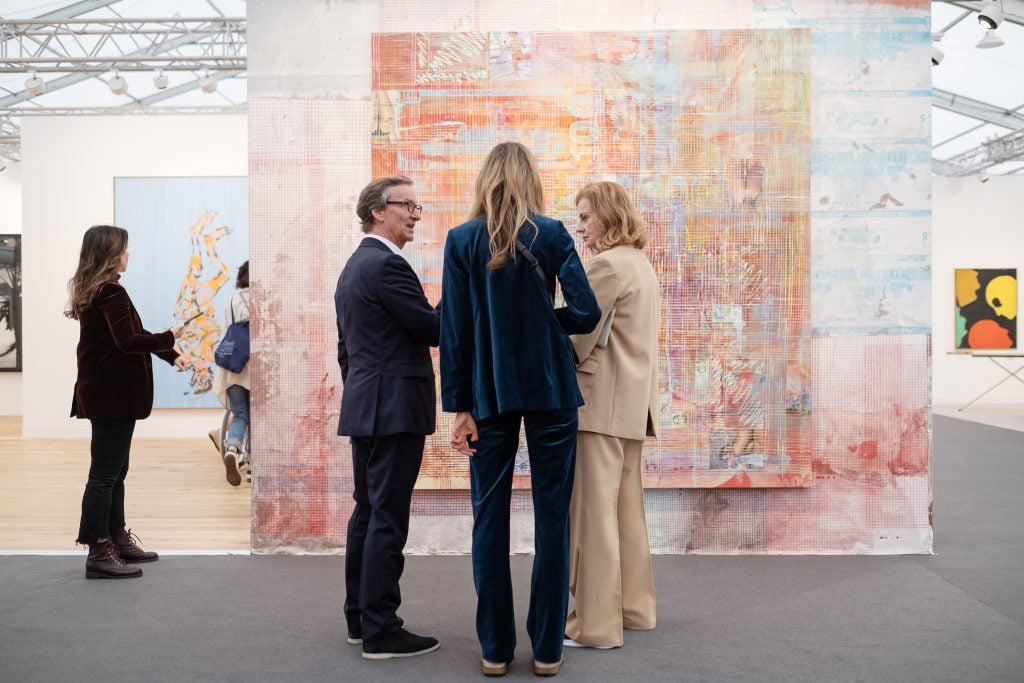
Thaddaeus Ropac, Frieze London 2023. Photo: courtesy of Linda Nylind/Frieze.
A lot is at stake this Frieze week, considered the first proper warm-up of the season, a barometer before the big test of the November sales in New York. Following two years of escalating prices and market frenzy, this summer saw a slowdown, and after tepid auctions in Hong Kong, stakeholders are eyeing each other’s behavior carefully this week.
“The last few years were exceptional, and I think we are in a soft landing in the truest sense, but I think it is a good thing,” Ropac said. “People are slower in making decisions, which we like, actually. It is better for all of us to work in this ideal climate, where there is more time to discuss, and without the race of speed and pressure of last year.”
Frieze has done a good job of getting people excited about the fair’s anniversary, an optimism evinced by the 166 participating galleries this year, up 18 percent from last year. And stakeholders are determined to divert any sense of market despondency despite the dismal narrative surrounding London, woven-through with the knock-on effects of Brexit and Covid: inflation, a weak pound, rising interest rates, and growing competition from Paris.
Some are taking a pragmatic approach. “London is on sale,” art advisor Wendy Goldsmith said, nodding to the exchange rate. “That will keep the attraction to Americans, and to the rest of the world who also think in U.S. dollars.”
Still, there was concern that macroeconomic circumstances, plus the unfolding geopolitical events in the Middle East, might put people off a buying mood.
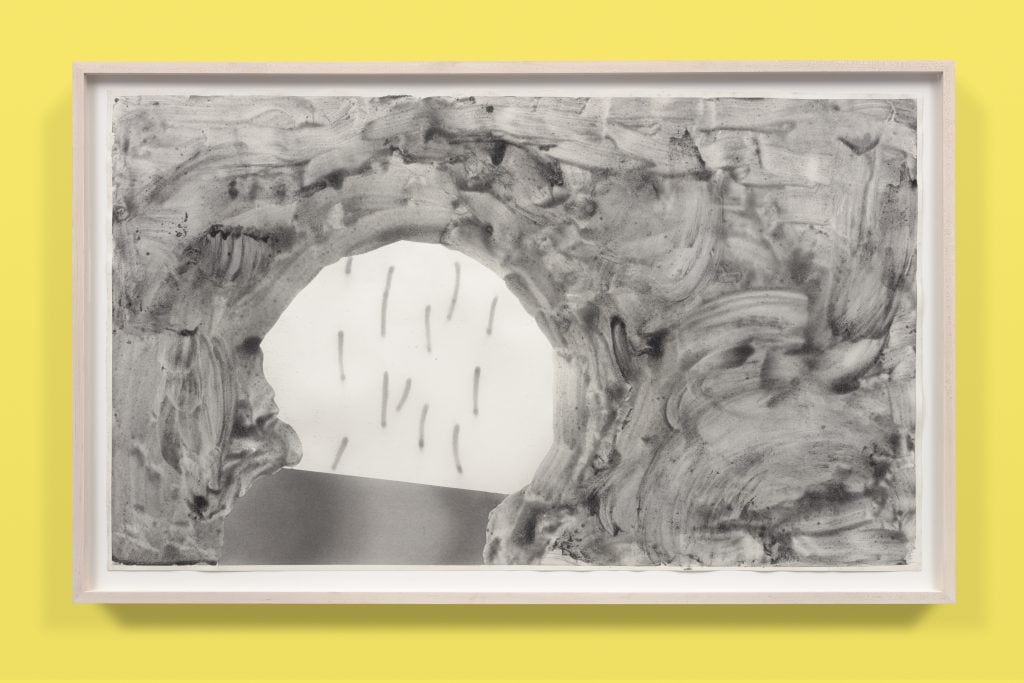
Deborah Anzinger, Untitled (Transmutation 11) (2023). Courtesy of Nicola Vassell.
While some galleries were absent this year (Mother’s Tankstation, Galerie König, and Matthew Brown among them), first-timers included the two-and-a-half-year-old Nicola Vassell gallery, whose founder told me it was a “logical step” to join Frieze as it begins charting an international presence. The gallery is presenting artist Deborah Anzinger in a new section this year titled Artist-to-Artist, for which the fair has invited established artists to curate a booth. Venice Biennale Golden Lion winner Simone Leigh nominated Anzinger, who is still unrepresented but will have a solo show at the gallery next winter. Anzinger is showing a suite of works on paper made with ground-up cookshop charcoal, a fuel used in her native Jamaica. Vassell reported some sales by end of day, and a number of “promising” conversations.
Massimo de Carlo was returning this year after a hiatus after deciding not to take part in art fairs in cities where the gallery has an outpost. This year it decided to reverse course in order to promote its new gallery on Clifford Street in Mayfair. The gallery had sold out its solo presentation of paintings by the Chinese artist Xiyao Wang, priced between €45,000 and €70,000 ($47,700–$74,300), by the time I visited the booth—all likely presold ahead of the fair.
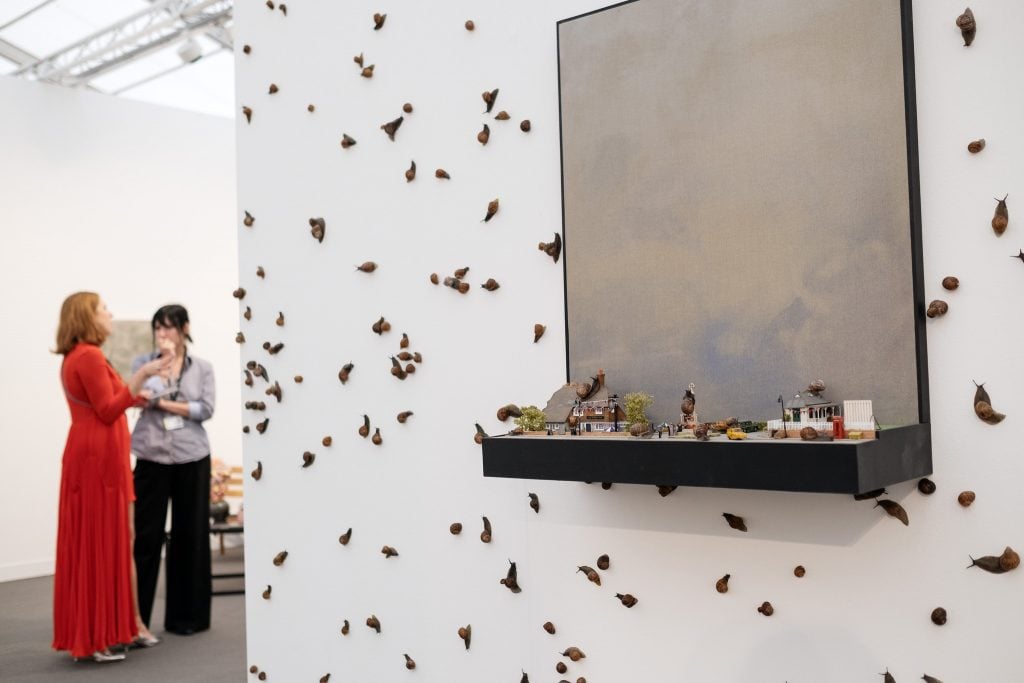
Seventeen, Frieze London 2023. Photo: courtesy of Linda Nylind/Frieze.
On its 20th anniversary edition, many were wondering whether Frieze’s organizers would encourage a return to the fair’s roots in experimentation; back in 2003 the Wrong Gallery proudly displayed an empty booth, having brought a notoriously hard-to-sell “constructed situation” by Tino Sehgal, and Paola Pivi invited visitors to roll down a grassy slope. In the end of the day, there were few extraordinary presentations and a lot of paintings, reflective of a curbed appetite for risk-taking in moment of economic downturn.
What was on view included a lot of color, and an emphasis on fun, eccentricity, and a British sensibility. Pilar Corrias’s booth was awash with color thanks to a Sophie von Hellermann mural and carpeting; Patrick Goddard’s army of snails climbing up the exterior walls of Seventeen gallery’s booth was already on hold in the early minutes of the fair, as was a surreal fragmented self-portrait on an oversize charm bracelet by Gillian Wearing at Maureen Paley. Shown in the artist’s solo at the Solomon R. Guggenheim Museum in New York during the pandemic, it had an asking price of £150,000 ($184,000).
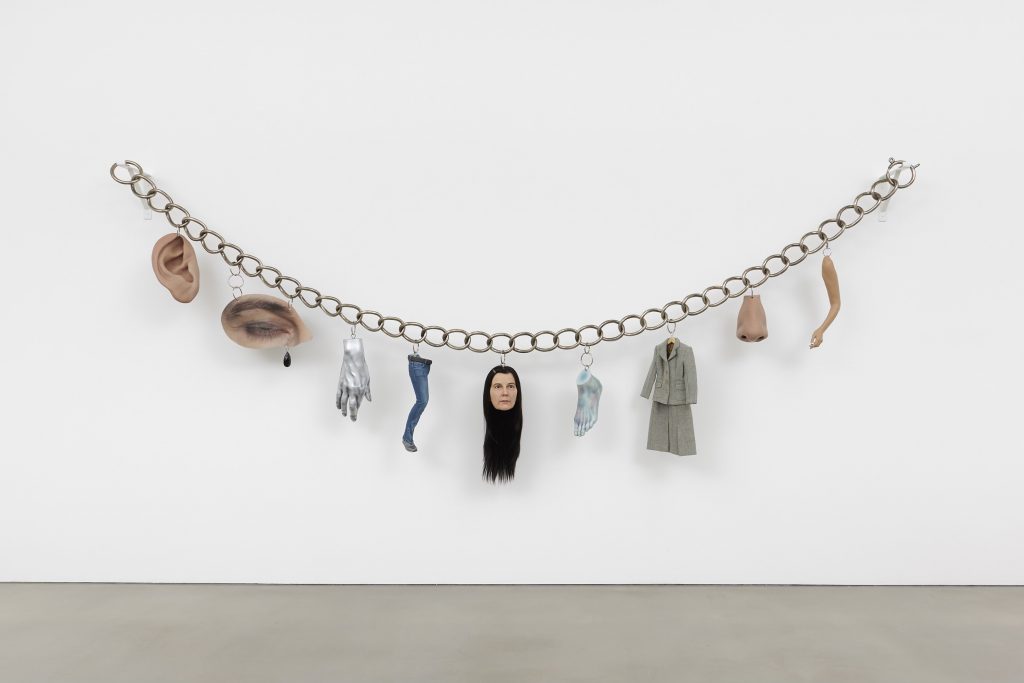
Gillian Wearing, My Charms (2021). ©️ Gillian Wearing, courtesy of Maureen Paley.
Frieze London’s defining focus is on living artists, and there were plenty of young talents who are growing in demand on view. Contrary to patterns in recent years, where there has been a turn away from the emerging sector during times of economic uncertainty, there was still plenty of demand for the new and now, attributed by gallerists and advisors to the interests of a new collector generation. Pace quickly sold a painting by in-demand artist Pam Evelyn, the youngest artist on its roster, which we understand had an undisclosed asking price of $75,000.
“There’s definitely been a recalibration, but buyers are still active, they’re just more focused now,” advisor Diane Abela said. “I remember when they would just want a name, not caring about the quality of the work. Now they actually want a good work.”
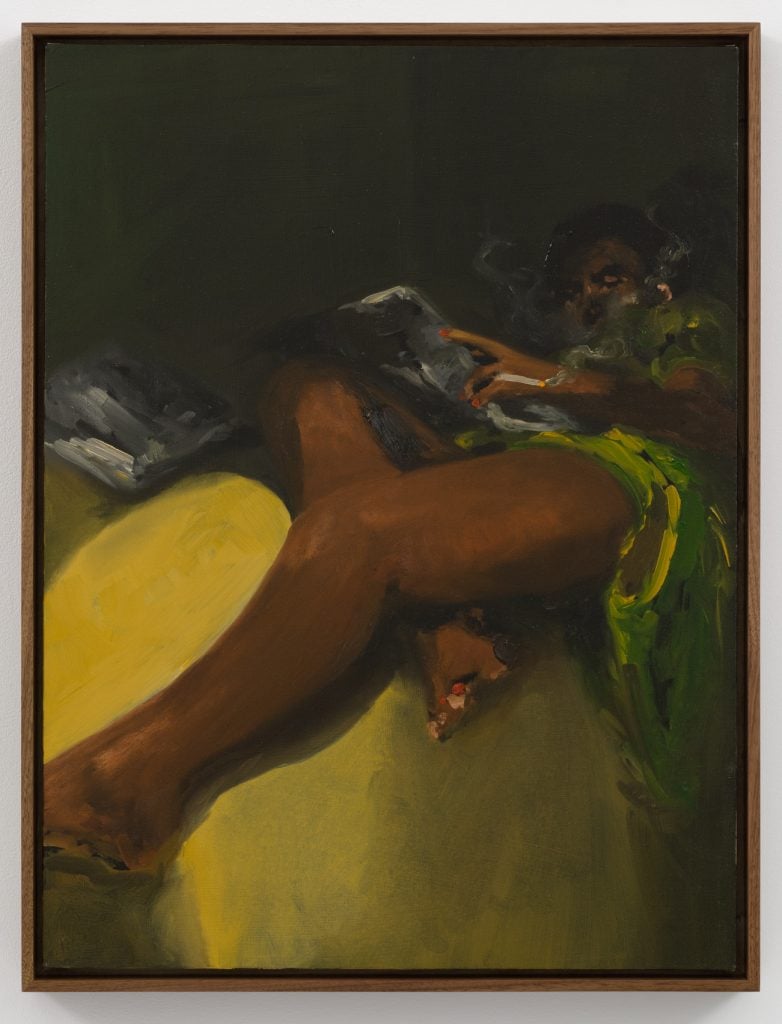
Danielle Mckinney, Hindsight (2023). Photo: Pierre Le Hors. © Danielle Mckinney, courtesy of the artist and Marianne Boesky Gallery, New York and Aspen.
Collectors were elbowing each other out of the way for a chance to acquire works by Danielle Mckinney in a solo booth at Marianne Boesky. Mckinney’s intimate and cinematic portraits depicting Black female protagonists have gathered a devoted following, and the Frieze presentation marked her first U.K outing after a $201,600 auction debut at Christie’s in the spring. Mckinney was in good spirits on the booth and seemed to be keeping a steady head on her shoulders despite the market clamor. “I’m staying grounded. For me it’s about making a good piece. I recently transitioned from acrylic to oil and I’m focused on technique, not on the market and who is buying it,” she said.
Boesky had sold out the booth in the days preceding the fair, prioritizing museum placements, but that didn’t stop collectors interrupting our conversation to beg for a work. Bucking a trend of escalating primary market prices in recent years as galleries hoped for a share of the speculation, Boesky has opted to keep the buy-in sane, between $45,000 and $65,000. “I wanted to keep prices institutions can afford,” she said, adding that she prefers this approach to the common BOGO practice, where collectors donate a work to a museum in order to win access for one themselves.
Still, Boesky acknowledged the wider slowdown. “This is not a good reflection of the market because this is a solo booth by an artist who is in demand. Elsewhere it is slower, but overall people are still quite active.”
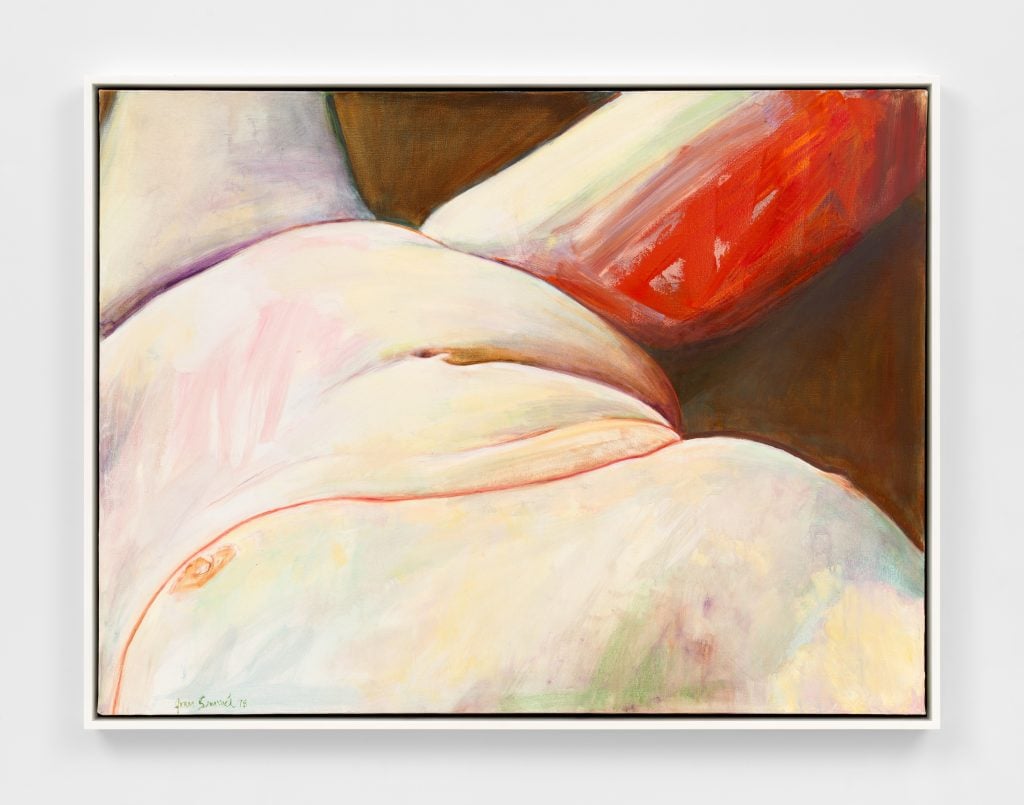
Joan Semmel, White skin (2018). © 2023 Joan Semmel / Artists Rights Society (ARS). Courtesy of the artist and Xavier Hufkens, Brussels, and Alexander Gray Associates, New York. Photo by Dan Bradica.
On the other end of the spectrum, there was a more significant presence of older living artists. “Galleries are now trying to take the estates of undervalued, under-the-radar established artists, as opposed to six months or a year ago, when they were all chasing very young artists,” art advisor Sibylle Rochat commented.
Work by Antiguan artist Frank Walter, who is gaining posthumous reappraisal, including in a show on view at the Garden Museum, was attracting attention at David Zwirner and Xavier Hufkens—Zwirner sold multiple paintings priced between $35,000 and $55,000. Also on view at Hufkens, and at Alexander Gray Associates, was the 91-year-old American painter Joan Semmel, whose solar-hued expressionistic feminist nudes are being deservedly recognized institutionally. The works at Alexander Gray were all on hold for collectors in the early hours of the fair (the gallery does not disclose prices), and the painting at Hufkens sold for approximately $200,000.
At Edel Assanti, there was Sylvia Snowden, an 81-year-old abstract painter who was a contemporary of Sam Gilliam; a painting by 83-year-old Color Field painter Peter Bradley—whose auction market has been taking off in the past two years, was on view at Karma with an asking price of $200,000; and Hauser and Wirth sold two works on paper priced at $120,000 from their exquisite solo presentation of sculptor Barbara Chase-Riboud. Speaking to this trend, gallery president Iwan Wirth said collectors were “embracing the idea that younger artists and new art don’t have a monopoly on revolutionary thinking and radical risk-taking.”
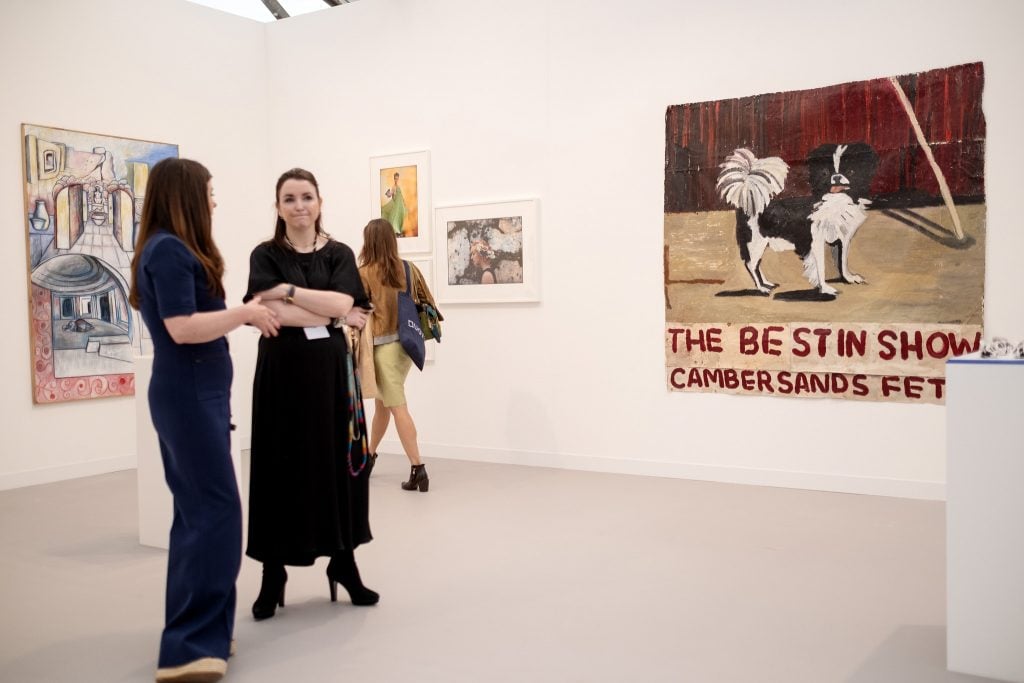
Alison Jacques, Frieze London 2023. Photo: Linda Nylind, courtesy of Linda Nylind/Frieze.
So what do the results this year portend for the market? Many galleries this year chose to take their heavy hitters to Frieze Masters, and the top prices reported by close of day were certainly lower than last year. In 2022, the highest price reported on opening day was $6 million for a Kerry James Marshall painting at David Zwirner. The gallery has since decided not to share secondary market prices, so may well have traded more significant figures, but reported a Gerhard Richter sale for $650,000 among the first day highlights.
Still, there were a number of works reported sold at asking prices of more than $1 million on opening day. Ropac had sold a Georg Baselitz for €1.2 million ($1.47 million), Goodman Gallery parted ways with a major El Anatsui work for $1.9 million, and Tracey Emin paintings sold at White Cube and Hufkens for £1.2 million and £900,000 ($1.47 million and $1.1 million).
It should be noted that a softer market does not necessarily show itself in lack of sales; rather in easier access to once-rare gems, galleries more open to negotiation, and stabilizing prices that had been on a vertical trajectory. All told, the day-one picture was much brighter than feared; as Boesky put it: “The market is not gangbusters, but it’s not bad, either.” We’ll take it.